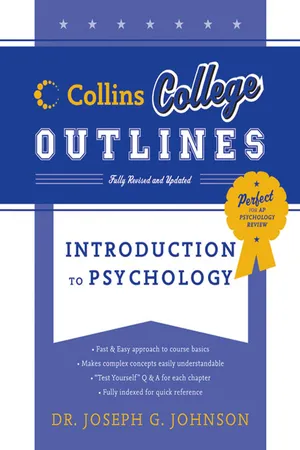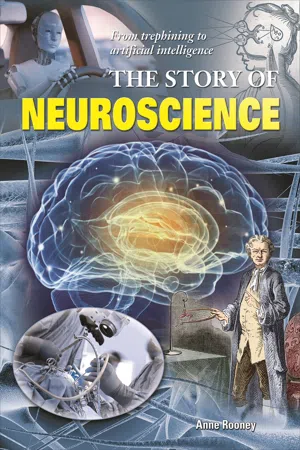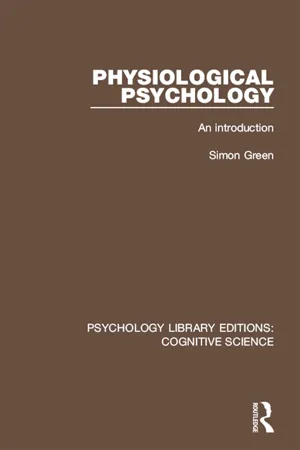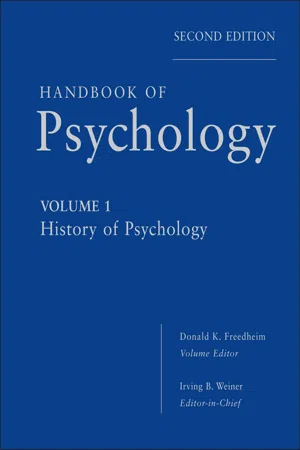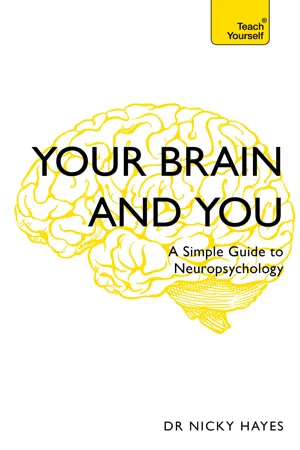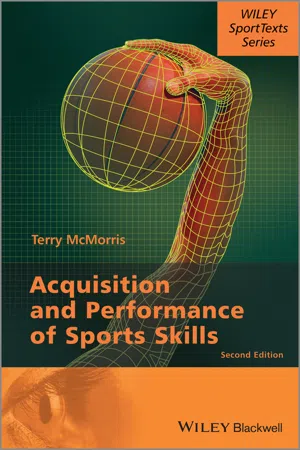Psychology
The Five Senses
The five senses refer to the sensory modalities through which humans perceive the world: sight, hearing, taste, smell, and touch. Each sense is associated with specific sensory organs and neural pathways that transmit information to the brain for processing. These senses play a crucial role in shaping our experiences and interactions with the environment.
Written by Perlego with AI-assistance
Related key terms
8 Key excerpts on "The Five Senses"
- Nancy Fenton, Jessica Flitter(Authors)
- 2015(Publication Date)
- Research & Education Association(Publisher)
Chapter 6 Sensation and PerceptionWhat does one know about his or her world? Since the beginning of scientific psychology, psychologists have been interested in understanding sensation and perception and how these two interconnected processes relate to cognition and behavior. Psychophysics , a branch of psychology strongly influenced by German scientist Gustav Fechner , studies how physical stimuli (sensations) translate to psychological experiences (perceptions). Sensation involves how an organism receives stimuli and information from the surrounding world via the sensory organs. Psychophysicists investigate the human senses, including vision, audition (hearing), gustation (taste), olfaction (smell), somatic (touch, temperature, pain), vestibular, and kinesthetic. Each sense has specific receptor cells located in the sense organs, which transform physical stimuli into neural impulses in a process known as transduction . The complementary process to sensation is perception , which involves the interpretation of sensations. Perception includes the cognitive processes of receiving, encoding, storing, and organizing sensations.STUDY TIPBe able to distinguish between the processes of sensation and perception .ThresholdsHow intense does a stimulus have to be to produce a sensation? Psychophysicists have answered this question with absolute thresholds , or the minimum intensity of stimulation needed for detection 50 percent of the time. For example, an experimenter attempting to find an individual’s absolute threshold for sound may walk away from the individual with a ticking watch. As soon as the individual cannot reliably hear the watch 50 percent of the time, the experimenter has determined that individual’s approximate absolute threshold for sound.A subliminal stimulus is a weak stimulus presented below threshold that cannot be consciously registered. Research has questioned if very weak or quick stimuli below one’s level of consciousness can be interpreted; this is known as subliminal perception . Although subliminal commands to change behaviors have not been confirmed, there is some evidence that subliminal stimuli may have a subtle influence on behavior, but the influence is neither strong nor long-lasting. Any claims by advertisers that subliminal messages can change complex behaviors, such as ending addictions or learning a new language, are not- eBook - ePub
- Ann L. Weber, Joseph Johnson(Authors)
- 2011(Publication Date)
- Collins Reference(Publisher)
CHAPTER 5Sensation
B asically everything we know about the world comes to us through our senses. These include vision, audition, the skin senses such as touch and sensitivity to heat and cold, the chemical senses of taste (gustation) and smell (olfaction), as well as internal senses dealing, for example, with nutrient and salt levels of the blood and the angles of the joints (proprioception).BASIC PRINCIPLESEach sensory organ (for example, the eye, ear, skin, nasal passage, or tongue) and its corresponding information pathway is uniquely structured to receive a particular form of physical energy, translate it into the electrochemical energy of neural impulses, and transmit this information to the brain. The field of psychophysics (see also Chapters 1 and 6) has taught us a great deal about how physical energy is related to psychological experience. First, we cover here some principles that apply across sensory modalities, before examining each sense in more detail.From Physical to PsychologicalThe first step for any sensory modality is the transformation of physical signals into neural signals, the language of the nervous system; this process is called transduction . For example, the ear and auditory system turn physical vibrations into psychological sounds, while the eye and visual system turn physical light into psychological images. Each sensory system is equipped with specialized receptors (sensory neurons) that detect a particular form of energy or chemical. Sensory neurons are essentially the first link in the chain of sensory information, receiving signals from the physical world rather than via dendrites from other neurons. Furthermore, receptors and other neurons have specific receptive fields - eBook - ePub
- Anne Rooney(Author)
- 2017(Publication Date)
- Arcturus(Publisher)
CHAPTER 6
Senses and SENSIBILITY
Johannes Müller, 1840‘Sensation consists in the sensorium receiving through the medium of its nerves, as a result of the action of an external cause, a knowledge of certain qualities or conditions not of external bodies but of the nerves themselves.’While the motor system’s principal task is to cause muscles to contract, thereby producing movement, the primary job of the sensory system is to detect stimuli from outside and within the body. These stimuli, which include light, sound, smell, touch and taste, are processed by the brain to enable us to interact with our surroundings. The results of the processing might activate the motor system or they may remain internal to the brain, producing memory, understanding or emotion.A ride such as this provides a multitude of sensory signals to the brain, producing both physical and emotional responses .Dividing the work
Even the ancients distinguished between sensory organs that acquire data and the ‘sensorium’, be it brain or heart, which processes the data into a sense experience of which we are conscious. The mechanism can be broken down into the reception of a stimulus, transfer of the stimulus to the sensorium, and processing of the stimulus.Early work on the senses focused on how sensory perceptions work mechanically. Later, scientists began to wonder about how much the senses have in common, and how they differ.An optometrist can correct faults in the sensory organ – the eye – using lenses or surgery, but addressing vision problems that originate in the nerves or brain is much more difficult .Inside and outside
The external senses – vision, hearing, touch, taste and smell – are all concerned with the relationship of our bodies to the outside world. This means that in discovering how they work, we not only need information about the way our nerves and brains work, but also some knowledge of how matter is constructed and of phenomena such as light and sound. Before we developed a good understanding of topics such as optics, audio and chemistry, there was really no hope of knowing how our senses work. - eBook - ePub
Physiological Psychology
An Introduction
- Simon Green(Author)
- 2016(Publication Date)
- Routledge(Publisher)
With each of our senses, or modalities, we respond to (or are aware of) a range of stimuli; we see bright and dark objects, hear high-pitched and low-pitched sounds, taste sweet and sour foods. The range we respond to represents only a proportion of the available range, and for every sensory modality we could find another species with a different battery of sensory receptors and which therefore responded to a different range of stimuli. So, to return to my opening point, each species constructs its own view of the world, based upon the surrounding stimuli it can transduce into the sensory information which serves as the basis of perception; but although each species occupies a unique perceptual niche, related species such as the higher mammals usually show substantial similarity in the structure and organization of sensory systems.Our sensory systems may be readily divided into the five traditional modalities – vision, hearing, touch, smell, taste -plus pain and proprioception, which concerns the awareness of bodily movement and position in space. They may be further classified into functional groups: e.g. exteroceptive senses, covering those modalities dealing with the outside world such as vision, hearing, touch, taste, and smell; proprioceptive senses (as above); and interoceptive senses, covering those sensory receptors handling information from internal structures, such as pressure receptors and glucose receptors in the walls of blood vessels. However, the most straightforward approach is to consider the various sensory modalities one by one. I shall outline the organization of sensory systems dealing with touch, taste, and smell, cover pain and hearing in more detail, and then discuss the visual system at length. Although this matches relative importance as assessed by the amount of research devoted to each, it should be emphasized that the hearing or auditory system in particular is as relevant to the psychologist as the visual system.TouchThe sensation of touch comes in various forms, all involving stimulus contact with a variety of touch receptors in the skin. The sensations include light and heavy touch pressure, tickling and movement of a stimulus across the skin, cold and warmth, and pain. Categories overlap – a cold stimulus applied with heavy pressure can result in pain. - eBook - ePub
- (Author)
- 2012(Publication Date)
- Wiley(Publisher)
Chapter 5 Sensation and Perception Stanley Coren The Perceptual Problem Sensation, Perception, Reason, and Cognition Physics and Visual Perception Physiology and Perception The Science of Illusion The Rise of the Behavioral Laboratories The Psychophysicists and the Correspondence Problem The Gestaltists and the Correspondence Problem The Progress of Perceptual Research Bibliography ReferencesThe study of sensation and perception covers many diverse topics. This is partly the result of the length of time that perceptual problems have been studied. The ancient Greek philosophers some 2,500 years ago were already investigating this topic, and they were followed by the pre-Renaissance thinkers, the Arabic scholars, the Latin scholastics, the early British empiricists, the German physicists, and the German physicians who founded both physiology and psychology; all considered issues in sensation and perception to be basic questions. When Alexander Bain (1855) wrote the first English textbook on psychology, it was entitled The Senses and the Intellect, with the most extensive coverage reserved for sensory and perceptual functions. During the first half of his career, Wilhelm Wundt (who is generally credited with the founding of experimental psychology) focused much of his research on sensory and perceptual issues.Because there is such a long history of perceptual research, it is not surprising that we have amassed a huge database covering substantive issues about how the specific sensory systems operate and how we extract and interpret information from them. It would be possible to write a multivolume book just on the history of visual perception, another on auditory perception, or yet other volumes on the history of sensory and perceptual studies of the tactile, olfactory, or gustatory modalities. Even specific aspects of perception, such as the perception of pain, could generate their own full volume outlining the history of the major substantive findings and theoretical treatments of this single aspect of sensory experience. In addition to the large empirical database that has resulted from the long history of research in this area, the study of perception has been affected by many schools of thought. Each has its own major theoretical viewpoint and its own particular set of methodological techniques. Thus, we encounter psychophysicists, gestaltists, functionalists, structuralists, transactionalists, sensory physiologists, analytic introspectionists, sensory-tonic theorists, “new look” psychologists, efferent theorists, cognitive theorists, information processors, artificial intelligence experts, and computational psychologists, to name but a few. There are even theorists (such as some behaviorists) who deny the existence of, or at least deny our ability to study, the conscious event we call perception. How, then, can a single chapter give any coherent treatment of the issues associated with this fundamental aspect of psychology? - eBook - ePub
Your Brain and You
A Simple Guide to Neuropsychology
- Nicky Hayes(Author)
- 2018(Publication Date)
- Teach Yourself(Publisher)
5 Experiencing other sensesIn this chapter you will learn:• all about our sense of smell and how it works• how our sense of taste makes us sensitive to a range of tastes and textures• how the sense of touch detects pressure and temperature• how we feel pain and how we can learn to control it• that there are many kinds of sensory illusion, including phantom pain and synaesthesia.Have you ever smelled something that brought back a flood of memories? Or touched something which felt quite different from the way it looked? Vision and hearing are our most important senses, but we have several others as well (see Figure 5.1 ). The ancient Greeks identified three more – touch, taste and smell – so people often assume that we have five senses. In reality, though, we have many more. We have different sense receptors for heat, for movement, for pain and for balance, for example, and we know something (although not everything) about how the brain processes each of these. In this chapter we will look at our other senses of smell, taste, touch, and pain. Then we’ll go on to look at sensory illusions such as phantom pain, and what we know about synaesthesia – when our senses overlap or seem to replace one another.The sense of smellFigure 5.1 Sensory areas of the brainWe are bathed in a sea of information, all the time. Our vision detects a small proportion of the electromagnetic radiation that surrounds us; our sense of hearing detects certain wavelengths of the vibrations in the air around us; and our chemosensory system – the senses of smell and taste – detects chemicals, in the air around us and in the things we put into our mouths.It is likely that the sense of smell was the second of the main senses to evolve. Taste was probably first, of course, because it’s an immediate reaction to what is in contact with us. Smell, though, allows us to locate things at a distance. For the earliest animals, smell and taste were probably the same: an animal swimming in the primeval oceans would sample the chemicals in the water around it, and use that information to detect aspects of its surroundings. Even a simple one-celled animal like an amoeba makes slight chemical changes to the water it swims in, so having a sense that can detect chemical traces would be an important survival trait – both for detecting food and for avoiding becoming it. - eBook - ePub
- Terry McMorris(Author)
- 2014(Publication Date)
- Wiley(Publisher)
2 Sensation and Perception of External InformationLearning objectives
At the end of this chapter, you should be able to:- understand what is meant by indirect or inferred perception
- describe how information processing theorists explain perception, with particular reference to:
- – signal detection theory
- – nature and role of selective attention
- – nature and role of visual search
- – how individual differences affect perception
- understand what is meant by direct perception
- have a basic knowledge of how ecological psychologists explain perception, including
- – nature and importance of affordances
- – how perception and action interact to detect affordances
- understand the main criticisms of information processing and ecological psychology theories with regard to perception
- be aware of the main developmental factors affecting perception.
In this chapter we examine, from an information processing perspective, how we perceive external information particularly for the purposes of making decisions. From an ecological psychology stand point, we are looking at how perception and action combine to recognize the existence of affordances in the environment. The role of perception in the control of movement is covered in Chapter 6 .Information processing theory, sensation and perception
Although information processing theorists argue that sensation and perception are different, the two concepts tend to be treated as one. The senses, which are the most important in the perception of information for decision making, are visual and auditory receptors. Vision is generally considered to be the most important of the senses. Light rays enter the eye through the lens and are detected by the retina. The central portion of the eye, the fovea, is rich in nerve receptors, which allow it to extract detail from an object. The range of foveal or central vision depends on how the eye is focused. This is controlled by the ciliary muscles, which are on either side of the lens. The range is generally regarded as being between 2° and 5°. The vision outside of this range is referred to as peripheral vision. The receptors, here, are less dense and images are less distinct than those found in foveal vision. Although foveal and peripheral vision are commonly used terms, Trevarthen (1968) used the terms focal and ambient vision. Focal vision is identical to foveal vision, but ambient vision differs a little to peripheral vision. According to Trevarthen, ambient vision - Constance Classen, Constance Classen(Authors)
- 2014(Publication Date)
- Bloomsbury Academic(Publisher)
CHAPTER FIVE _____________________________________The Senses in Philosophyand Science: From theSenses to Sensations
ROBERT JÜTTEIn the first half of the nineteenth century many philosophers challenged the canonical number of senses. The Spanish theologian Jaime Balmes (1810–48), for example, did not rule out the existence of more than the traditional five:For, to the eyes of philosophy, the phenomenon of sensation consists in the production in the soul of a particular affection determined by an impression on an organ; and of whatever order this affection may be, and whatever organ may be affected, the animal phenomenon is substantially the same. The difference is in the class of affections and of the organ which is their medium. The essence of the phenomenon does not change. And if by sensations we understand such distinct orders of affections as those of sight and of touch, why may we not include other impressions caused by any other organ, whatever that organ may be?Balmes 1856, I: 329The quest to discover new senses gained strong momentum in natural philosophy. According to Friedrich Wilhelm Schelling (1775–1854), natural philosophy (Naturphilosophie) does not deduce the real from the ideal, on the contrary the ideal derives from the real. Natural forces and phenomena, such as irritability and sensibility, explain the forms in which the ideal structure of nature is realized. In his treatise on the system of the senses, Schelling relates the senses to three dimensions (magnetism, electricity, and chemism). He posits six instead of five senses, adding thermoception (Wärmesinn). His scheme differs, however, from the traditional one not only according to quantity. He correlates, for instance, smelling with electricity and touch with magnetism. Also, the order of the senses and their combination is quite peculiar: feeling, taste (= senses of the first order in regard to the organism), smell and sight (= senses of the second order), thermoception and hearing (= senses of the third order). Schelling also increases the importance of the sense of hearing by referring to it as the “proper sense of humanity” (der eigentliche Sinn der Humanität
Learn about this page
Index pages curate the most relevant extracts from our library of academic textbooks. They’ve been created using an in-house natural language model (NLM), each adding context and meaning to key research topics.

